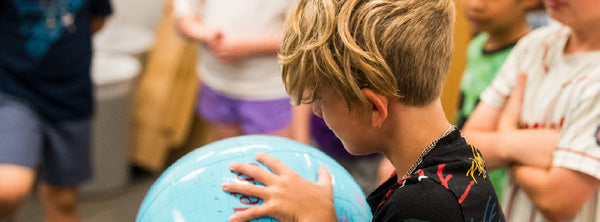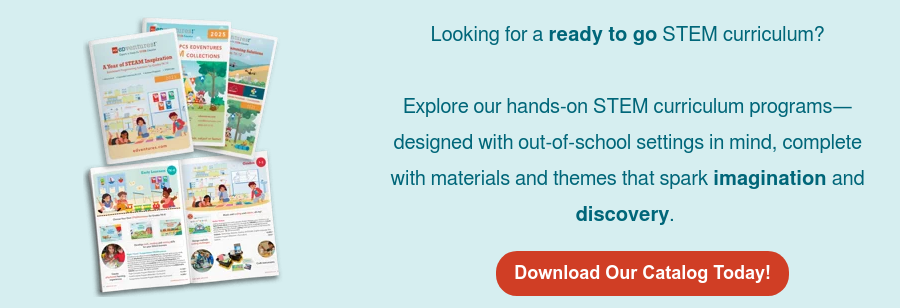
5 Ways to Incorporate STEM Into Your After-School Program
Level Up Your After-School Program with These 5 Engaging STEM Strategies
Want to make your after-school program the highlight of the day? STEM holds the key! These five practical strategies will bring hands-on excitement to your program and spark curiosity in every learner.
1. Ignite Curiosity with Hands-On STEM Projects 🔥
The key to STEM engagement is doing. The Next Generation Science Standards stress active participation, and research shows hands-on experiences, particularly in informal environments, lead to deeper understanding (STEM After School, 2014). By including hands-on STEM projects, your program becomes a 21st Century learning environment that supports higher level thinking skills, student engagement and collaboration.
✏️ Try this:
- Building Challenges: Provide simple materials (like straws, craft sticks, tape or even marshmallows) and challenge learners to build the tallest tower or a bridge that can hold a small toy. Check out our Typhoon Towers Design Challenge, inspired by our Build a Better World program for hands-on engineering fun!
- Kitchen Science: Explore concepts like density with a layered liquid experiment (water, oil, dish soap) or make slime to learn about polymers. Want to really wow your learners? Download our Cloud in a Jar activity to bring weather science to life!
- Simple Machines: Use building bricks or craft sticks to build levers, pulleys or inclined planes. Our Soar Like Superman with STEM activity, inspired by The Science of Superpowers, gets learners excited about STEM while building catapults and exploring simple machines.
Need more ideas? Visit our STEM Freebies on our blog for more fun, ready-to-use activities.
Plus, become a STEMbassador—it's free!—and get the inside scoop on the latest STEM news, invaluable resources and dynamic webinars designed to supercharge your program.
🏆 Hands-on projects turn your space into a hub of discovery, where learners think like scientists, engineers and innovators.
2. Break It Down with Bite-Sized STEM Activities 🧩
After-school time goes by quickly. Lengthy projects and unpredictable attendance can lead to frustration. The solution? Micro-lessons. Dividing larger concepts into smaller, thematically linked segments increases student engagement and retention. It’s a win-win for your program.
✏️ Try this:
- Coding Unplugged: Teach basic coding with games that use directional cards—no computers required.
- Nature Scavenger Hunt: Strengthen observation skills with a hunt for specific leaves, rocks, or bugs. Find inspiration for your own successful outdoor scavenger hunt with our Teaching STEM in the Great Outdoors: Symmetry Scavenger Hunt.
- Pattern Recognition: Use colorful beads or blocks to create and extend patterns, introducing early computational thinking. For more ideas, read Building Computational Thinking in Young Learners.
🏆 Short, focused activities build confidence and momentum, allowing learners to explore STEM concepts at their own pace.
3. Set Learners Up for Success with Realistic Goals ✅
Clear, achievable goals make a big difference—especially in after-school settings. Focus less on perfect outcomes and more on the process of STEM: asking questions, making predictions and testing ideas (STEM After School, 2014).
✏️ Try this:
- "Ask 3 Before Me" Rule: Encourage students to seek help from peers before asking an adult.
- Engineering Design Challenges with Constraints: For example, "Build a tower at least 10 inches tall using only straws and tape."
- Observation Journals: Have learners draw and describe something they observe.
🏆 Focusing on the process teaches persistence, creative problem-solving and reflection—key 21st-century skills.
4. Fuel Independence with Student-Driven STEM 🚀
After-school programs thrive when students have voice and choice. Student-driven activities allow for different interests, learning speeds and support needs.
✏️ Try this:
- STEM Interest Centers: Set up themed stations—like a building zone, coding puzzles, or nature exploration—and let students rotate or choose their favorite. A podcasting station is a guaranteed hit. Grab our Geek Out With STEM Podcasting activity for easy implementation ideas inspired by our popular Discover Podcasting enrichment program.
- Passion Projects: Encourage students to investigate a STEM topic that excites them, offering guidance as needed. Explore the stories of Extraordinary Young Inventors, these STEM role models are sure to spark curiosity in your learners.
- Student-Led Demonstrations: Let learners share their projects or discoveries with the group.
- Competition: Learners love competitions. Research local STEM-related competitions in your area and get your learners involved.
🏆 When students take ownership of their learning, they gain independence, confidence and a sense of purpose.
5. Celebrate Progress with Meaningful Assessment ✨
Don't shy away from assessment just because it's an after-school setting. Meaningful assessment encourages growth. Focus on tracking progress and highlighting how far learners have come.
✏️ Try this:
- "What I Learned Today" Journals: Have learners briefly write or draw one thing they learned or enjoyed during the STEM activity.
- Project Showcases: Organize informal events where learners can present their creations or findings to their peers or parents.
- "Skills Checklist": Create a simple checklist of STEM skills (e.g., "I can make a prediction," "I can work with a partner") and have students self-assess or have instructors observe and check off skills as they are demonstrated. Check our Executive Functioning Skills: Learner Checklists for a free downloadable self-assessment.
🏆 Recognition fuels engagement. Whether it’s a journal entry, a proud presentation or a completed checklist, these small moments reinforce learning.
Final Thoughts
By starting small and incorporating these concrete, actionable strategies, you can transform your after-school program into an exciting and valuable STEM learning experience that students will look forward to!
Featured Programs:

The world of comic books is full of heroes, villains, challenges and triumphs — and the heroes need help! Ready to see just what it takes to be super? In this educator favorite, learners dissect their superhero skill sets to uncover the science behind superpowers.
How do you incorporate STEM learning in your after-school program?
Share your ideas in the comments below.

Author: Carolyn Gilberti
With over ten years experience teaching art and library, Carolyn champions hands-on, project-based learning. Her passion lies in fusing art, technology and science to create powerful connections for learners.















